HOUSEPLANTS > ORCHIDS > PHALAENOPSIS

Ed is a horticultural therapist, professional gardener and writer. Ed has a BSc in Occupational Therapy from Coventry University and a Diploma in Social and Therapeutic Horticulture (DipSTH) via Thive, the RHS and Pershore College. Ed runs a community kitchen garden in West Sussex, where he leads horticultural therapy sessions.
Reviewed By COLIN SKELLY

Colin is a Horticulturist and Horticultural Consultant with experience in a range of practical and managerial roles across heritage, commercial and public horticulture. He holds the Royal Horticultural Society’s Master of Horticulture award and has a particular interest in horticultural ecology and naturalistic planting for habitat and climate resilience.
Contributions From KEN GRIFFITHS

As a lover of orchids that has been growing and caring for these plants for around 45 years, Ken is now the Chairman of Bournemouth Orchid Society, of which he has been a member since the 1980s. The society won a Silver-Gilt Medal at the RHS Wilsey Orchid show in 2022. Ken has also spoken at many events as a guest speaker, sharing his knowledge of orchids with hundreds of people.

Malcolm has been growing orchids for 30 years and had lots of experience searching for, growing and caring for orchids. He previously ran his own business providing orchid sundries to hobbyist growers and he also delivers lectures to various orchid and gardening clubs across the UK. Malcolm is currently the Chairman, Vice President and Show Secretary of the Solihull & District Orchid Society.

Mark is the Technical Manager at Love Orchids, having had 35 years of experience in ornamental plant production, including 15 years growing Phalaenopsis orchids. He works at Love Orchid’s site in the New Forest.
ORCHID GUIDES
Dendrobium
Feeding
Phalaenopsis
Reblooming
Varieties
Watering
For a touch of the exotic, Moth Orchids, or ‘Phalaenopsis’ as they are botanically named, can’t be beaten and will brighten up any room.
Flowering for months on end in an array of colours, they are not as difficult to grow and care for as is often thought and actually grow well in a centrally heated environment.
In this guide, we feature three specialists:
- Ken Griffiths – Chairman of Bournemouth Orchid Society.
- Malcolm Moodie – Chairman, Vice President and Show Secretary of the Solihull & District Orchid Society.
- Mark Riley – Technical Manager at Love Orchids.
“What makes me passionate about growing orchids is the phenomenal variety of both plants and flowers that are available and the beauty of the flowers and their longevity,” says Ken.
“They are one of the largest families of flowering plants and can be found worldwide in many diverse habitats, growing both epiphytically and terrestrially.”
Overview
| Botanical Name | Phalaenopsis |
| Common Name(s) | Moth Orchid |
| Plant Type | Houseplant |
| Native Area | Southeast Asia |
| Hardiness Rating | H1A |
| Foliage | Evergreen |
| Flowers | Moth-shaped on arching stems |
| When To Plant | Anytime |
| When To Prune | After flowering |
Sunlight
Preferred
Indirect Light
Exposure
Sheltered
Size
Height
0.3 – 1M
Spread
0.1 – 0.5M
Bloom Time
Winter / Spring
Soil
Preferred
Bark or moss
Moisture
Well-drained
pH
Acidic
Phalaenopsis are part of the Orchidaceae family and according to the RHS, they are the most commonly grown type of indoor orchid in the UK.1Indoor orchids. (n.d.). Royal Horticultural Society. Retrieved March 22, 2023, from https://www.rhs.org.uk/plants/types/orchids/indoor
Often called the ‘Moth Orchid’, their petals resemble the wings of a moth or butterfly and appear to daintily float at the end of long arching stems.

First introduced from Asia to the United Kingdom in the 19th century, orchids became a status of wealth in the Victorian era and were prized by plant hunters.2Lu, W. (2018, March 1). Behind the Beauty of Orchids, Centuries of Violence. Edge Effects. Retrieved March 22, 2023, from https://edgeeffects.net/orchids/
“Orchids are the largest family of flowering plants on earth with over 30,000 listed species,” says Malcolm.
“They grow from the Arctic Circle to the Tropics and from sea level to in excess of 10,000 feet, making them an extremely widespread and variable family of plants.
“This means you need to learn a great deal about their habitats in order to grow them successfully, which makes growing orchids challenging and immensely interesting.”
Orchids can encompass many species including Cymbidium, Paphiopedilum and Oncidium.
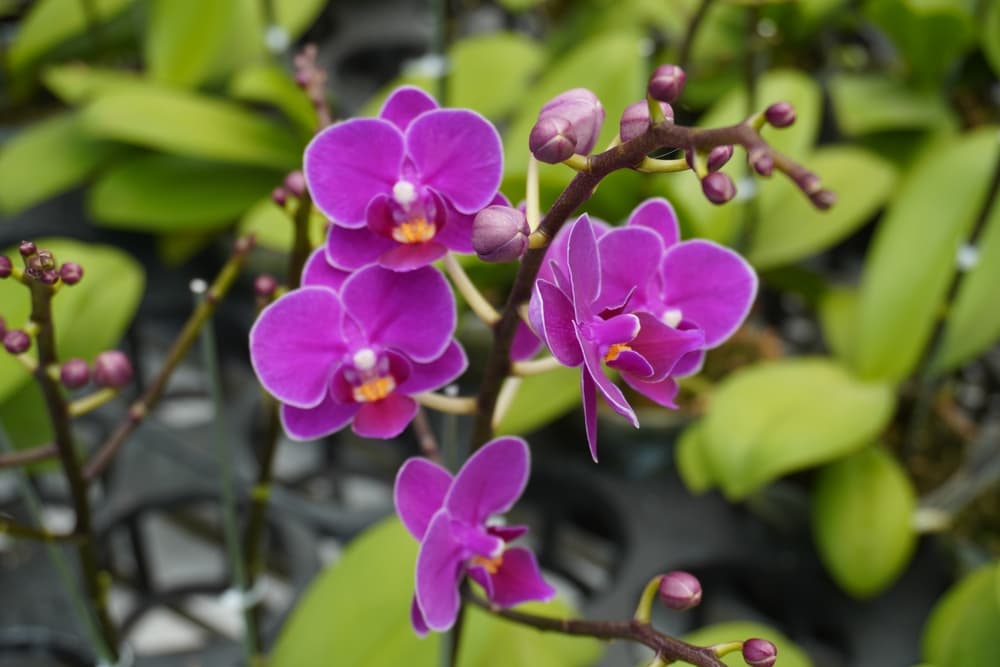
However, possibly the easiest to grow and the most widely available here in the UK is Phalaenopsis.
“Orchids are one of the largest families of flowering plants, ranging from very inconspicuous types growing naturally in the UK countryside to large exotic types growing in rainforest tree canopies,” says Mark.
“The breeding and development of commercially produced phalaenopsis orchids has allowed everyone to have colourful, exotic-looking flowering plants in our homes that are actually easy to look after.”
Common Indoor Varieties
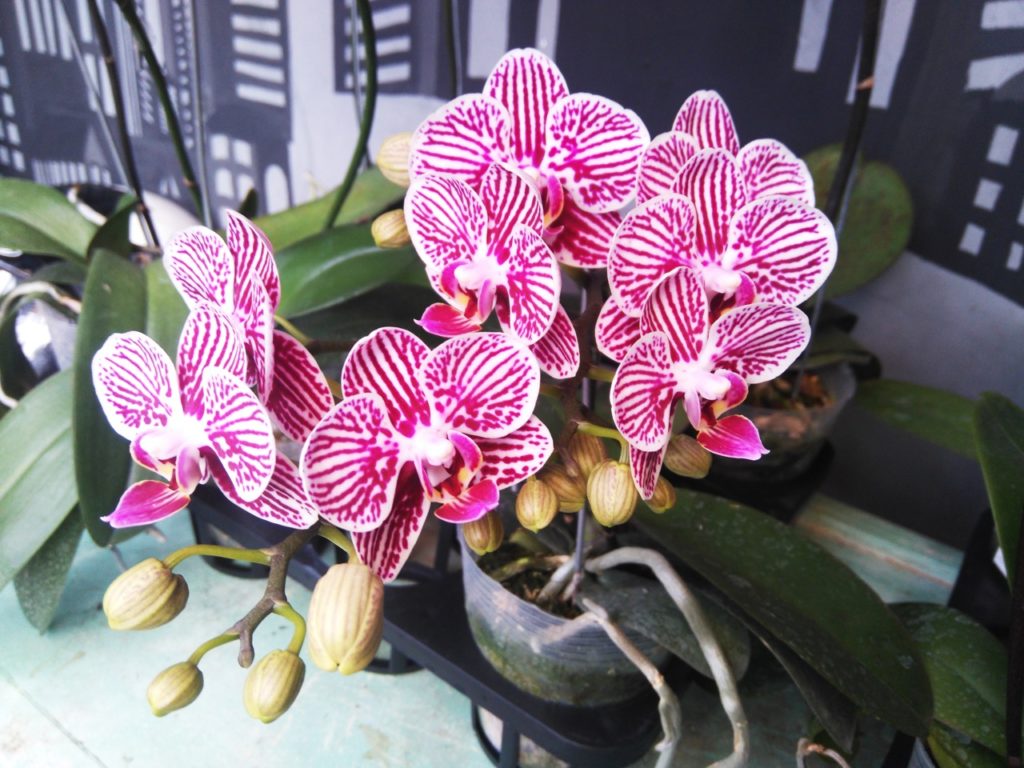
These days, moth orchids are readily available to buy from garden centres and even supermarkets and come in a huge range of colours from white and pink to yellow and purple, all of varying heights.
- P. ‘Yellow Lightning’ (produces yellow flowers and red-edged petals)
- P. amabilis (larger orchid with white flowers up to 10cm across)
- P. grandiflorum ‘Rio Grande’ (purple and pink fringed flowers)
Slightly more exotically coloured, watercolour orchids have their name as they often undergo a process of injecting coloured dye into the stems of the plant.

These varieties will tend to flower again, however, they will revert back to their original colour of usually white or light pink.
“Initially, a grower new to growing orchids should concentrate on growing Phalaenopsis Hybrids, as they are freely available and extremely tolerant of growing conditions,” says Malcolm.
“Once a grower is confident in growing this type of orchid, they can then be more adventurous by choosing other Phalaenopsis species for growing in the home or, indeed, establishing a dedicated greenhouse for orchid culture.”
Where To Grow
Orchids can be a little particular about where they are placed.
They prefer a constant temperature rather than one that fluctuates, so it is best to avoid spots near radiators or draughty windows, as cold draughts can make their buds drop.
“Remember that phalaenopsis orchids are naturally epiphytes, so they grow on trees,” Mark explains.
“The roots need air, very little water and very little nutrition. The leaves need good light conditions but avoid direct sunlight in the summer as this could scorch them.”
Caring For Phalaenopsis
Temperature & Humidity
“Orchids have specific temperature requirements depending on the genera and fall into three main groups: cool, intermediate and warm,” says Ken.
Phalaenopsis falls into the ‘warm’ category and should be kept in a place with minimum temperatures of 18-20°C during the day and 16°C at night.
“Avoid temperature swings of more than 10°C from night to day,” Mark adds.
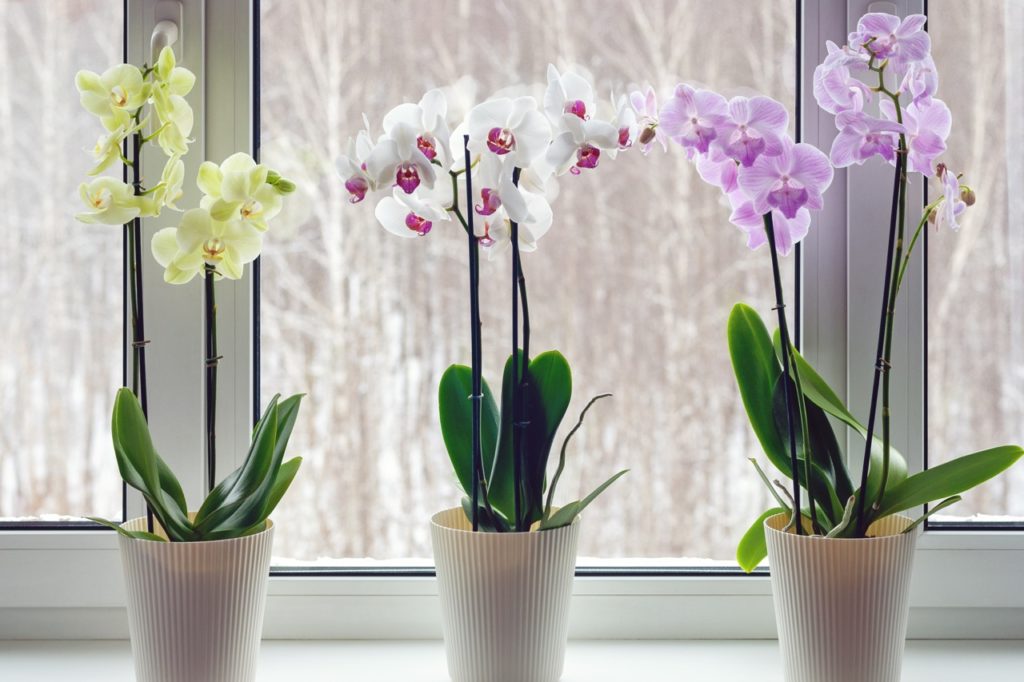
Orchids prefer a humidity level of 50-70% and will struggle in very dry air, Ken explains:
“It is important to maintain a humid environment around orchid plants to avoid desiccation.”
This can be achieved by placing the plant on a tray of wet pebbles or gravel, especially during the autumn and winter when higher humidity is most required.
“A kitchen or bathroom can often provide a more humid environment, although the aspect will need to be right too and many modern houses have low humidity by design,” explains Colin Skelly, a Master Horticulturist..
“I have an east-facing but bright bathroom and only windows to control the humidity – so a few humidity-loving plants have made it home!”
Watering
“Watering can be a challenge, as more orchids are killed by overwatering than otherwise, as this can lead to rotting and destruction of the root systems,” Ken explains.
It is important to give an orchid the correct amount of water as if given too little, the roots may dry out and with too much, they may rot.
To avoid root rot, orchid roots mustn’t be left to sit in water, so when watering, any excess must be allowed to drain away freely.
“With the common moth orchid, make sure you do not get water on the crown of the plant, as this will rapidly lead to rotting and the loss of the plant,” says Ken.
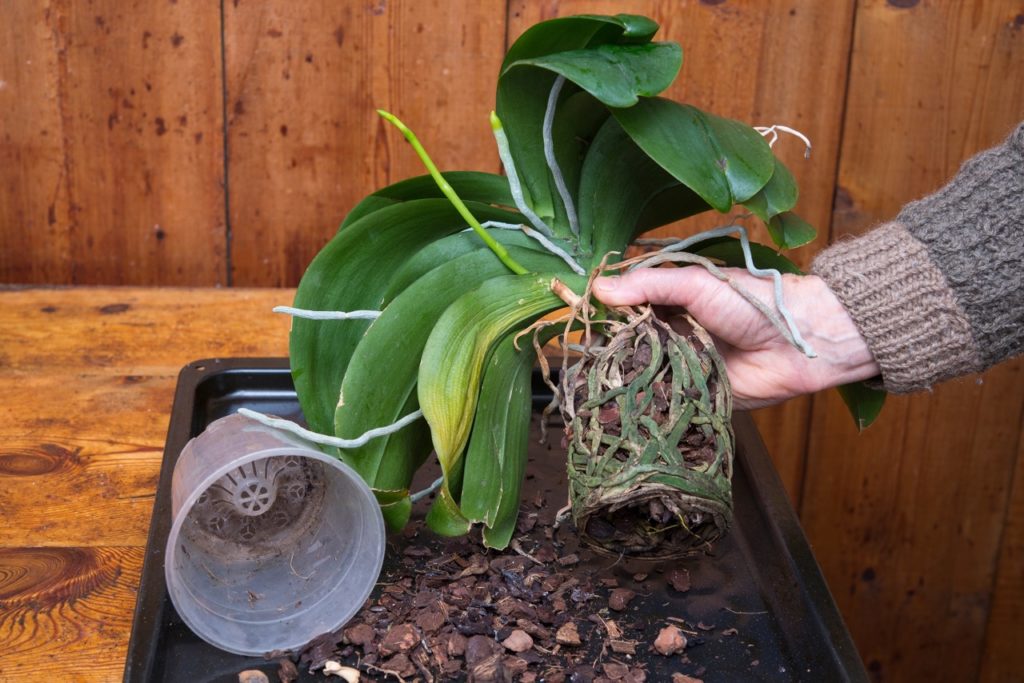
In general, orchids need to be watered every 1-2 weeks.
“Water very minimally to avoid run-off or soak the pots once a week for 30 minutes, then allow all the surplus water to drain away,” says Mark.
However, this may need to be increased during the growing season and reduced during the winter months.
“Orchids, by and large, do not like their feet in water as a significant proportion, including Phalaenopsis, are epiphytic,” says Malcolm.
Sunlight
Phalaenopsis need lots of bright but indirect light to remain healthy and grow well.
“In the home, avoid direct sunlight and do not place directly above radiators or other sources of dry heat,” says Ken.
If placed in too much or too strong direct light the leaves can be damaged and the flowers might drop prematurely.
An east or north-facing window sill tends to be fine as long as they avoid the midday harsh sun, or alternatively, artificial lights will suffice.
“For Phalaenopsis in the home, grow the plant on a windowsill that is not south-facing,” advises Malcolm.
Soil Requirements
In their native environments, Phalaenopsis grow on trees rather than in the ground so they need a light and airy growing medium, as opposed to normal compost or soil, which would kill them.

Specialist growing media for orchids can be bought online and often include a mix of sphagnum moss, coco and bark chips.
“Overpotting is a common mistake and the various composts used must always allow air to the roots,” Ken explains.
Fertilising
“Orchids, due to their epiphytic nature in the species form, are weak feeders and should not be fed too rigorously, as salts might build up in the growing medium,” warns Ken.
However, to encourage flower production and healthy growth, orchids need to be fed regularly during the growing season, but only with a specific orchid fertiliser.
“When orchids are in active growth, use a high-nitrogen fertiliser and then switch later in the year to a high-phosphorus one to encourage flowering,” says Ken.
It is advisable to carefully adhere to the dosage instruction though, as overfeeding (as mentioned) can potentially cause more harm than good.
After Flowering
Once an orchid has bloomed it needs a period of rest or dormancy before they prepare to flower again.
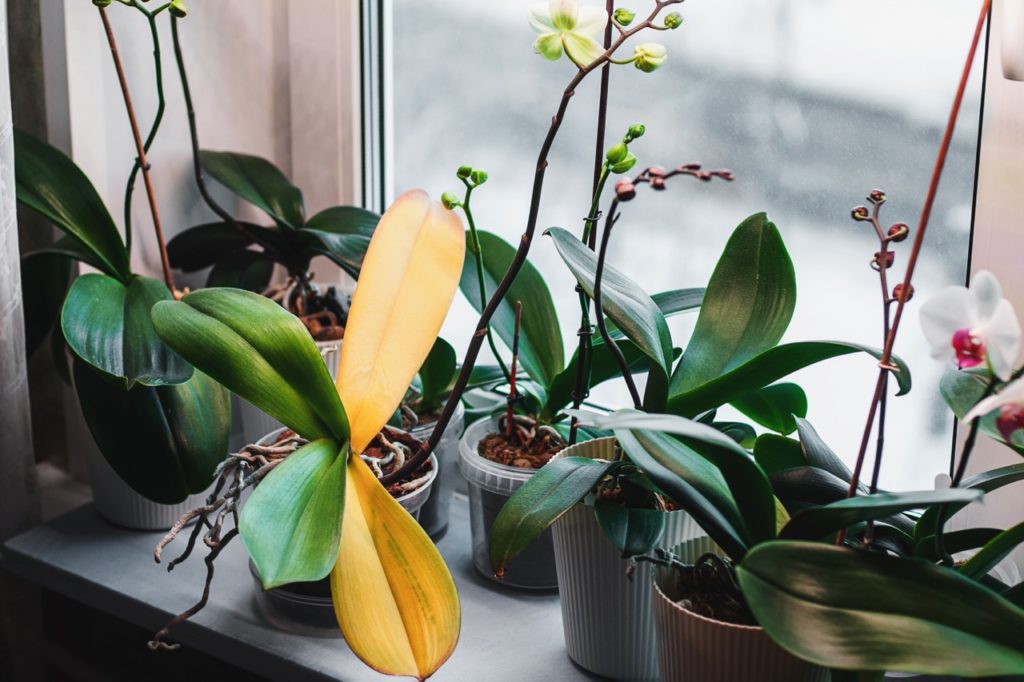
After flowering, most of the blooms will fall off by themselves, if not they can be gently teased off the stem, after which the stem can be cut back to a healthy-looking joint.
“Phalaenopsis are relatively easy to flower year after year once they have settled into a suitable home environment,” Malcolm says.
Pruning
Pruning an orchid can appear a scary task but is actually quite a simple process.
After the flowers have dropped, the stem can be cut back using a clean pair of secateurs or snips, to a node just beneath the flowers.
“With the moth orchid, once it has finished flowering, cut the spike down to just above a node on the old spike,” advises Ken.
Common Problems
Perhaps the most common problem when growing orchids is getting them to flower again.
If they have been cared for correctly and still have not bloomed again, the plant can be placed in a spot a few degrees cooler at night than it previously was which can help encourage bud stimulation.
“After deadheading, lower the temperature by 10°C,” suggests Ken.
“This will commonly induce reflowering.”
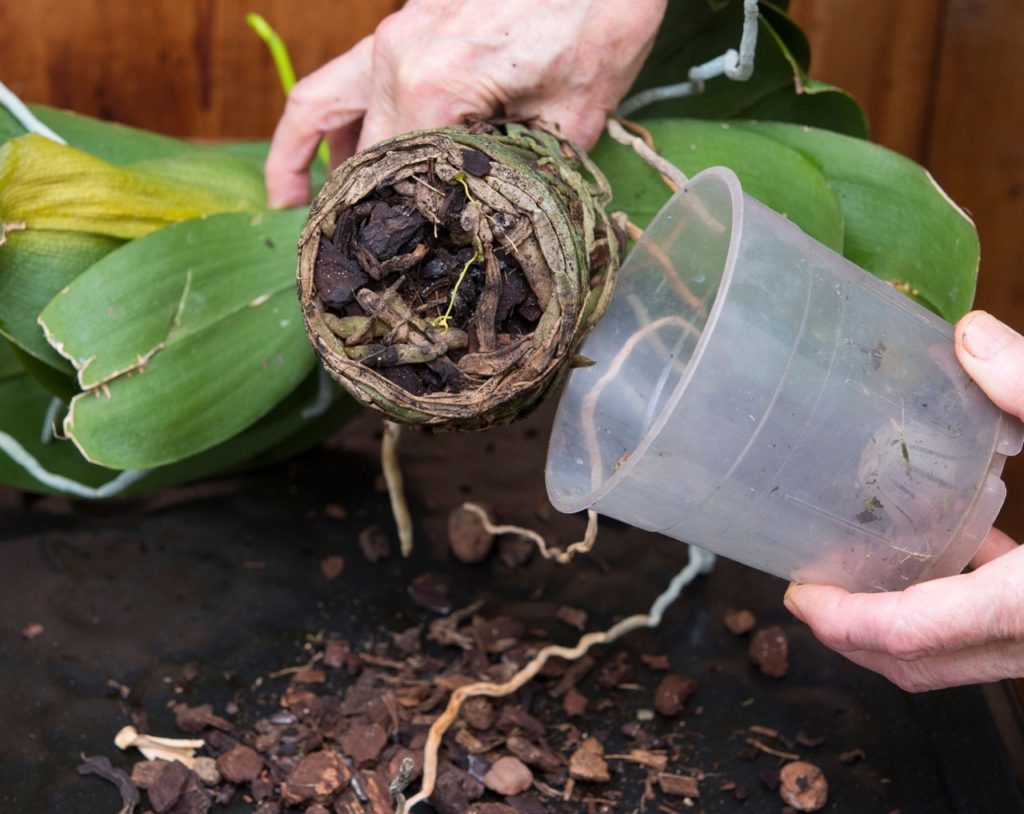
Root damage as a result of over or under-watering is also common and will affect the overall health of the orchid.
It is often advised to grow an orchid in a clear pot to make regular checks of the roots more feasible.
“Common pests such as mealy bugs, scale insects and aphids are sometimes encountered but are usually easily controlled if caught early enough and good cleanliness rules are adhered to,” Ken says.
“There are a number of pesticides on the market which effectively control common pests.”
Transplanting & Repotting
Repotting orchids is only necessary every couple of years if the plant has grown too big for its current pot or if the growing media has begun to smell.
To repot, carefully lift the orchid from its pot and gently remove any growing media from around its roots.
Once the roots are free, any unhealthy brown or squidgy roots can be cut off.
The remaining healthy roots should be white or grey and firm and if necessary, can be pruned back to 10-12cm in length.
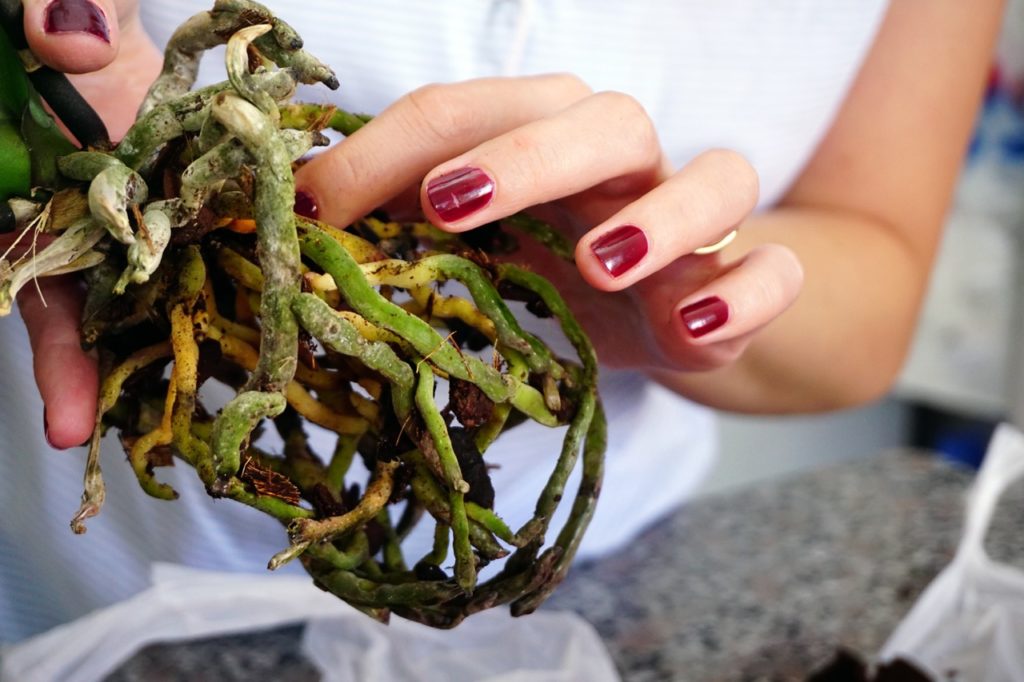
Repot using one size up only and don’t be tempted to use a much larger pot as the plant will struggle.
Place the orchid in its new pot and carefully backfill it with a new potting mix, filling the spaces between the roots.
Gently firm in the new potting mix so that on lifting the plant the pot does not fall away.
Add a cane or support and tie in if required then water well, allowing any excess water to drain away and not sit in the pot.
Propagating
Orchids can be grown from seed, but this is perhaps best left to commercial growers due to the time involved.
Thankfully, orchids can produce baby plants themselves on their current stems called keiki.
These keikis will, in time, produce their own leaves and roots and can be carefully cut off with a sterile knife once 5-7cm long.
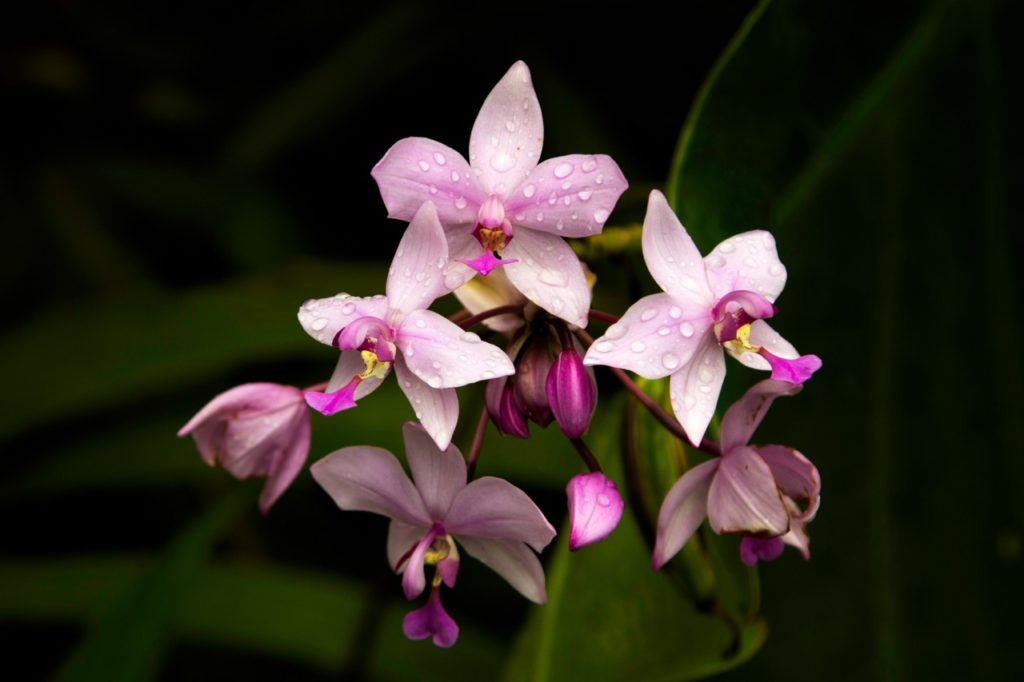
The newly separated plant can then either be potted up in a small container or planted alongside the parent plant in the same pot.
Once large enough, the new plant can be potted on and cared for in the same way.
Propagating orchids can be an immensely satisfying experience, however, patience is required as it may take 2-3 years before the new plant will flower for the first time.
FAQs
How Do I Keep My Orchid Blooming?
Providing an orchid with the correct temperature and the appropriate amount of water and fertiliser is sometimes enough to encourage the plant to flower again.
Correct pruning is also important, as if a flower stem is cut when it is still green then any future blooms may be lost.

However, by lowering the nighttime temperature for 3-4 weeks in autumn so that it is 4-5°C cooler than in the day will often encourage new blooms to emerge.
Can You Water Orchids With Tap Water?
If at all possible, rainwater should be used to water an orchid as it will be free from any supplementary chlorine.3Water and health. (n.d.-b). Water UK. Retrieved March 22, 2023, from https://www.water.org.uk/advice-for-customers/water-and-health/
However, tap water will suffice if you do not have access to rainwater.
Do You Water From The Top Or Bottom?
Orchids can be watered from above or below as long as all the growing medium and roots get a good soaking.

The main point to remember is that any water needs to be allowed to drain away freely and not collect at the bottom of the pot.
Do Orchids Do Well In Bathrooms?
Orchids thrive in humid and warm environments, so a bathroom is often ideal as long as the temperature can be controlled to suit the plant’s requirements.
References
- 1Indoor orchids. (n.d.). Royal Horticultural Society. Retrieved March 22, 2023, from https://www.rhs.org.uk/plants/types/orchids/indoor
- 2Lu, W. (2018, March 1). Behind the Beauty of Orchids, Centuries of Violence. Edge Effects. Retrieved March 22, 2023, from https://edgeeffects.net/orchids/
- 3Water and health. (n.d.-b). Water UK. Retrieved March 22, 2023, from https://www.water.org.uk/advice-for-customers/water-and-health/

